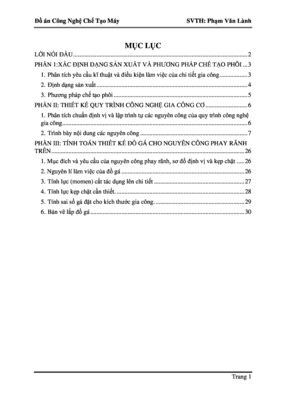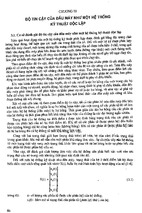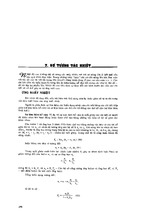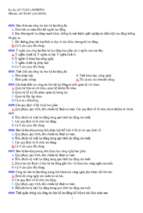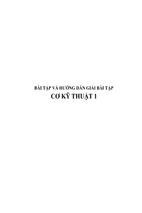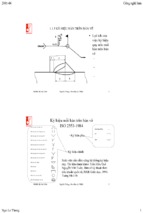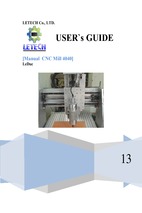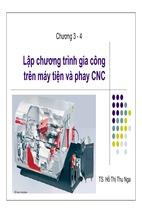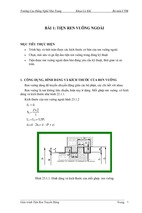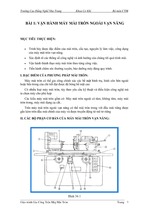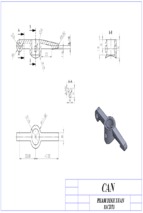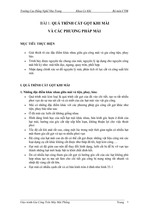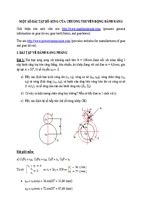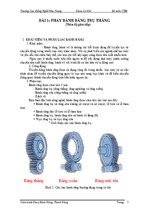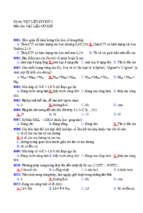April 2009
Design Guides for Plastics
Clive Maier, Econology Ltd
TANGRAM
TECHNOLOGY
This publication is made up of a series of articles published in Plastics and Rubber Weekly as a piece work. The
kind assistance of the author and PRW is acknowledged in the publication of the work.
The publication will be updated in a regular basis as new sections of the guide are published by PRW.
The design hints in this booklet are given in good faith and represent current good practice. The short nature of
the hints means that not all information can be included. No responsibility can be taken for any errors or
consequential damages resulting from using these hints.
This publication may be freely reproduced except for sale or advertising purposes. It may be hosted on web sites
for free downloading providing that it is used in it’s entirety and that reference is made to the original publication.
© Clive Maier 2004
Typeset by Tangram Technology Ltd.
Contents
Preface ........................................................................................... 1
Introduction ................................................................................... 2
Injection moulding......................................................................... 4
Basics
1.
2.
3.
4.
5.
Wall thickness .......................................................................................... 5
Corners...................................................................................................... 6
Ribs ........................................................................................................... 7
Bosses .................................................................................................... 10
Design for recycling .............................................................................. 13
Special features
6.
7.
8.
Living hinge ........................................................................................... 18
Bearings ................................................................................................. 20
Gears ....................................................................................................... 23
Assembly
9.
10.
11.
12.
13.
14.
15.
16.
17.
18.
Press fits ................................................................................................. 28
Snap-fits ................................................................................................. 29
Hot air staking ........................................................................................ 33
Ultrasonic welding.................................................................................. 38
Hot plate welding .................................................................................... 40
Spin welding ........................................................................................... 41
Friction welding ...................................................................................... 42
Induction welding ................................................................................... 43
Laser welding.......................................................................................... 44
Adhesive and solvent bonding .............................................................. 45
Special techniques
19.
20.
Design for outsert moulding ................................................................. 50
Design for gas assist injection moulding .................................. Planned
Extrusion..........................................................................................
21.
Design for profile extrusion ........................................................ Planned
Blow moulding.................................................................................
22.
Design for extrusion blow moulding .......................................... Planned
Thermoforming................................................................................
23.
Design for thermoforming ........................................................... Planned
Design information
24.
Design information sources................................................................... 63
April 2009
April 2009
Preface
This set of hints and tips for plastics product designers is intended as a source book and an 'aide
mémoire' for good design ideas and practices. It is a source book for plastics product designers at all
levels but it is primarily aimed at:
•
student designers carrying out design work for all levels of academic studies;
•
non-plastics specialists involved in the design of plastics products;
•
plastics specialists who need to explain their design decisions and the design limitations to nonplastics specialists.
The book covers each topic in a single page to provide a basic reference to each topic. This space
constraint means that each topic is only covered to a basic level. Detailed plastic product design will
always require detailed knowledge of the application, the processing method and the selected plastic.
This information can only be provided by raw materials suppliers, specialist plastics product designers
and plastics processors but there is a need to get the basics of the product design right in the first
instance.
Using the hints and tips provided in this guide will enable designers to reduce initial errors and will lead
to better and more economic design with plastics.
I hope this short work will improve the basic design of plastics products and if it can do this then it will
have served it’s objectives.
Clive Maier
ECONOLOGY Ltd.
1
1
April 2009
INTRODUCTION
Good design is important for any
manufactured product but for plastics it is
absolutely vital. We have no instinct for
plastics. Most of those we use today have
been around for little more than two
generations. Compare that with the
thousands of years of experience we have
with metals. And plastics are more varied,
more complicated. For most designs in
metals, there is no need to worry about the
effects of time, temperature or environment.
It is a different story for plastics. They creep
and shrink as time passes; their properties
change over the temperature range of
everyday life; they may be affected by
common household and industrial materials.
The philosopher Heidegger defined
technology as a way of arranging the world
so that one does not have to experience it.
We can extend his thought to define design
as a way of arranging technology so that we
do not have to experience it. In other words,
good design delivers function, form and
technology in objects that meet the needs of
users without making demands on them.
The well-designed object gives pleasure or
at least satisfaction in use, and does what it
should do without undue concern.
In these Design Guides we will set out the
basics of good design for plastics. The rules
and recommendations we give will
necessarily be generalisations. They will
apply often but not invariably to
thermoplastics, frequently but not
exclusively to injection moulding. The basic
advice will be good but because plastics are
so complex and varied the golden rule must
always be to consider carefully whether the
advice needs adjusting to suit your particular
application.
Good design combines concept with
embodiment. Unless the two are considered
together, the result will be an article that
cannot be made economically or one that
fails in use. This is particularly important for
plastics. It is vital to choose the right
material for the job. When that is done, it is
equally important to adapt the details of the
design to suit the characteristics of the
material and the limitations of the production
process.
Plastics come in a bewildering variety. There
are a hundred or more distinct generic
types. On top of that, advanced techniques
with catalysts and compounding are creating
new alloys, blends and molecular forms. All
of these materials can have their properties
DESIGN CONSIDERATIONS
modified by control of molecular weight and
by additives such as reinforcements. The
number of different grades of plastics
materials available to the designer now
approaches 50,000. The importance - and
the difficulty - of making the right choice is
obvious.
Plastics can be grouped into categories that
have roughly similar behaviour.
Thermoplastics undergo a physical change
when processed; the process is repeatable.
Thermosets undergo a chemical change; the
process is irreversible. A key distinction
between thermoplastics relates to the
molecular arrangement. Those with random
tangled molecules are called amorphous.
Those with a degree of molecular
arrangement and ordering are called semicrystalline. The difference is significant. For
example, most amorphous materials can be
fully transparent. And the more crystalline a
material is, the less likely it is to have a wide
'rubbery' processing region, so making it
less suitable for stretching processes like
blow moulding and thermoforming
Designers must design for process as well
as purpose and material. In single-surface
processes for example, there is only indirect
control over the form of the second surface.
Design must take this limitation into account.
2
April 2009
SOME COMMON PLASTICS
COMMON PLASTICS FORMING PROCESSES
3
April 2009
Part 1
Injection moulding
4
April 2009
1 WALL THICKNESS
Parts that might be made as solid shapes in
traditional materials must be formed quite
differently in plastics. Moulded plastics do not
lend themselves to solid forms. There are two
principal reasons for this. First, plastics are
processed with heat but are poor conductors
of heat. This means that thick sections take a
very long time to cool and so are costly to
make. The problems posed by shrinkage are
equally severe. During cooling, plastics
undergo a volume reduction. In thick
sections, this either causes the surface of the
part to cave in to form an unsightly sink mark,
or produces an internal void. Furthermore,
plastics materials are expensive; it is only
high-speed production methods and netshape forming that make mouldings viable.
Thick sections waste material and are simply
uneconomic.
So solid shapes that would do the job well in
wood or metal must be transformed to a
'shell' form in plastics. This is done by
hollowing out or 'coring' thick parts so you are
left with a component which regardless of
complexity is composed essentially of
relatively thin walls joined by curves, angles,
corners, ribs, steps and offsets. As far as
possible, all these walls should be the same
thickness.
It is not easy to generalise what the wall
thickness should be. The wall plays a part
both in design concept and embodiment. The
wall must be thick enough to do its job; it
must be strong enough or stiff enough or
cheap enough. But it must also be thin
enough to cool quickly and thick enough to
allow efficient mould filling. If the material is
inherently strong or stiff the wall can be
thinner. As a general guide, wall thicknesses
for reinforced materials should be 0.75 mm to
3 mm, and those for unfilled materials should
be 0.5 mm to 5 mm.
Ideally, the entire component should be a
uniform thickness - the nominal wall
thickness. In practice that is often not
possible; there must be some variation in
thickness to accommodate functions or
aesthetics. It is very important to keep this
variation to a minimum. A plastics part with
thickness variations will experience differing
rates of cooling and shrinkage. The result is
likely to be a part that is warped and
distorted, one in which close tolerances
become impossible to hold. Where variations
in thickness are unavoidable, the
transformation between the two should be
gradual not sudden so instead of a step, use
a ramp or a curve to move from thick to thin.
Thick sections and non-uniform walls cause
problems
Solid shapes must be redesigned as ‘shells’
Gradual transitions between thick and thin
sections
DESIGNER’S NOTEBOOK
� Keep wall thickness as uniform as possible.
� Use gradual transitions between thick and thin sections.
� Wall thickness must suit both function and process.
� Wall thickness guide range is:
0.75 mm to 3 mm for reinforced materials
0.5 mm to 5 mm for unreinforced materials
5
April 2009
2 CORNERS
When the ideas of correct and uniform wall
thickness are put into practice the result is a
plastics part composed of relatively thin
surfaces. The way in which these surfaces
are joined is equally vital to the quality of a
moulded part.
Walls usually meet at right angles, at the
corners of a box for example. Where the box
walls meet the base, the angle will generally
be slightly more than 90 degrees because of
a draft angle on the walls. The easiest way,
and the worst, to join the walls is to bring
them together with sharp corners inside and
out. This causes two problems.
The first difficulty is that the increase in
thickness at the corner breaks the rule of
uniform wall thickness. The maximum
thickness at a sharp corner is about 1.4
times the nominal wall thickness. The result
is a longer cooling time accompanied by a
risk of sink marks and warping due to
differential shrinkage.
The other problem is even more serious.
Sharp corners concentrate stress and
greatly increase the risk of the part failing in
service. This is true for all materials and
especially so for plastics. Plastics are said to
be notch-sensitive because of their marked
tendency to break at sharp corners. This
happens because the stress concentration
at the corner is sufficient to initiate a
microscopic crack which spreads right
through the wall to cause total failure of the
part. Sharp internal corners and notches are
the single most common cause of
mechanical failure in moulded parts.
The answer is to radius the internal corner,
but what size should the radius be? Most
walls approximate to a classical cantilever
structure so it is possible to calculate stress
concentration factors for a range of wall
thicknesses and radii. The resulting graph
shows that the stress concentration
increases very sharply when the ratio of
radius to wall thickness falls below 0.4. So
the internal radius (r) should be at least half
the wall thickness (t) and preferably be in
the range 0.6 to 0.75 times wall thickness.
If the inner corner is radiussed and the outer
corner left sharp, there is still a thick point at
the corner. For an internal radius of 0.6t, the
maximum thickness increases to about 1.7
times the wall thickness. We can put this
right by adding a radius to the outside corner
as well. The outside radius should be equal
to the inside radius plus the wall thickness.
This results in a constant wall thickness
around the corner.
Properly designed corners will make a big
difference to the quality, strength and
dimensional accuracy of a moulding. But
there is another benefit too. Smooth curved
corners help plastic flow in the mould by
reducing pressure drops in the cavity and
minimising flow-front break-up.
Good and bad corner design
Stress concentration factors for cantilever
loading
DESIGNER’S NOTEBOOK
� Avoid sharp internal corners.
� Internal radii should be at least 0.5 and preferably 0.6 to 0.75
times the wall thickness.
� Keep corner wall thickness as close as possible to the nominal
wall thickness. Ideally, external radii should be equal to the
internal radii plus the wall thickness.
6
April 2009
3.1 RIBS
So far in this design series we have seen
that plastics parts should be made with
relatively thin and uniform walls linked by
corner radii, not sharp corners. Both ideas
are important in the design of ribs.
When the normal wall thickness is not stiff
enough or strong enough to stand up to
service conditions the part should be
strengthened by adding ribs rather than
making the whole wall thicker. The principle
is the familiar one used in steel girders
where 'I' and 'T' sections are almost as rigid
as solid beams but are only a fraction of the
weight and cost.
A thicker section is inevitable where the rib
joins the main wall. This rib root thickness is
usually defined by the biggest circle (D) that
can be inscribed in the cross-section, and it
depends on the rib thickness (w) and the
size of the fillet radius (r). To avoid sink
marks, this thick region must be kept to a
minimum but there are constraints. If the rib
is too thin it will have to be made deeper to
give adequate rigidity and then it may buckle
under load. There are other problems too;
the mould becomes difficult to machine and
fill. And ribs filled under high injection
pressure tend to stick in the mould.
The fillet radius must not be made too small
either, or it will not succeed in reducing
stress concentrations where the rib joins the
main wall. Ideally, the fillet radius should not
be less than 40 percent of the rib thickness.
The ribs themselves should be between a
half and three-quarters of the wall thickness.
The high end of this range is best confined
to plastics that have a low shrinkage factor
and are less prone to sink marks.
A simple comparison shows the benefit of
good rib design. A rib that is 65 percent of
the wall thickness and has a 40 percent fillet
radius, results in a root thickness that is
about 1.23 times the wall thickness. By
contrast, the root thickness soars to 1.75
times the wall thickness when the rib is as
thick as the wall and has an equal radius.
Ribs of course must be extracted from the
mould, so they must be placed in the
direction of draw or provided with moving
mould parts to free them. Ribs should be
tapered to improve ejection; one degree of
draft per side is ideal. If the rib is very deep
the draft angle must be reduced or the rib
becomes too thin. For this reason ribs are
often limited to a maximum depth of five
times the rib thickness. So far, so good. But
how many ribs are needed to make a part
strong enough and how should they be
arranged? We will examine that in the next
Design Guide.
Ribs create thick sections at the root
How rib root thickness increases
DESIGNER’S NOTEBOOK
� Rib thickness should be 50 - 75% of the wall thickness.
� Fillet radius should be 40 - 60% of the rib thickness.
� Rib root thickness should not be more than 25% greater than
the wall thickness.
� Rib depth should not be more than 5 times the rib thickness.
� Taper ribs for mould release.
7
April 2009
3.2 RIBS
Ribs are used to improve the rigidity of a
plastics part without increasing the wall
thickness so much that it becomes
unsuitable for injection moulding. In the
previous guide we looked at the basics of rib
design. This time we will see how to put ribs
into practice.
Usually we want a part to be equally rigid in
all directions, just like a solid plate. We can
get almost this effect by running ribs along
and across the part, so they cross at right
angles. This creates a thick section where
the ribs cross but if we follow the design
rules for ribs and fillet radii the increase is
within acceptable limits - about 1.3 times the
wall thickness at the worst. This can be
reduced almost to the basic wall thickness
by forming a cored-out boss at the junction,
but a better solution is to use a normal
junction with ribs that are less than 0.75
times the wall thickness.
But how many ribs do we need and how
deep should they be? Rigidity is a function
of the moment of inertia of the rib section.
This tells us that the stiffening effect of a rib
is proportional to its thickness but
proportional to the cube of its depth. So
deep ribs are structurally much more
efficient than thick ribs.
A common task is to develop a relatively thin
ribbed plate that has the same rigidity as a
thick solid plate. Standard engineering text
books provide the basic formulae to make
the calculation but the mathematics can be a
chore to manage manually. To minimise the
work a number of ‘ready reckoners’ have
been devised, including an elegant cross-rib
solution developed by DuPont. Most of
these reckoners or calculators are based on
a particular set of assumptions so use with
caution if your design varies.
For example, the DuPont ribbed plate
calculator assumes the ribs are the same
thickness as the wall. To see how it works,
let’s imagine that we want to design a crossribbed plate with a 2.5 mm wall (tB) that will
be as stiff as a solid plate of 5 mm thick (tA).
Calculate tB/tA – the value is 0.5 – and find
this value on the left-hand scale. Rule a line
across to the right-hand scale and read off
the value which is 1.75. This value is T/tA
where T is the rib depth including the wall
thickness. So in our example, T = 1.75 times
tA which is 8.75 mm. Now read off the value
on the base scale vertically below the point
of intersection between the 0.5 line and the
curve. The figure is 0.16 and it represents
the product of tA and the number (N) of ribs
per unit of plate width (W). The curve
assumes that W is unity. So N equals 0.16
divided by tA which is 0.032 ribs per mm of
width, or one rib per 31.25 mm.
We can make a pro rata adjustment for ribs
that are correctly designed to be thinner
than the wall. If the ribs are 65 percent of the
wall thickness, the rib spacing becomes 65
percent of 31.25, making it 20 mm for
practical purposes.
Alternative rib junctions
Terms for the calculator
Cross-ribbed plate calculator Source: DuPont
DESIGNER’S NOTEBOOK
� Deep ribs are stiffer than thick ribs.
� Follow the basic rules for rib thickness and fillet radii.
� Calculate rib depth and spacing with a reckoner, or by using
math software or finite element analysis.
8
April 2009
3.3 RIBS
Ribs are important in the design of plastics
parts because they allow us to make a
component rigid without making it too thick.
We have already looked at the fundamentals
and seen how to design a cross-ribbed part.
Sometimes though, we only need rigidity in
one direction. This usually happens on a
long thin feature like a handle. In this case,
we can improve stiffness along the length of
the part by adding a number of parallel ribs.
These are called unidirectional ribs.
The first consideration is that these ribs
must not be too close together. This is
because the gap between the ribs is
produced by an upstanding core in the
mould. If this core is too thin it becomes very
difficult to cool and there may also be a
shrinkage effect that will cause ejection
problems. The usual rule is make the gap at
least twice the nominal wall thickness and
preferably three times or more.
As in the case of cross-ribs, design is based
on the principle that rigidity is proportional to
the moment of inertia of the wall section.
This provides a way of working out thin
ribbed sections that have the same stiffness
as thick plain sections. Calculator curves
make the job easier. Curves are available
for calculating deflection (strain) and stress
on various rib thicknesses. Our example
shows a deflection curve for rib thicknesses
equal to 60 per cent of the nominal wall
thickness.
For simplicity, the calculation splits the
unidirectional ribbed part into a number of Tsection strips, each with a single rib. The
width of the strip is known as the ‘equivalent
width’ or BEQ. To see how the calculator
works, we will design a ribbed part with the
same stiffness as a rectangular section 45
mm wide (B) by 12 mm thick (W d). We
decide on four ribs and a nominal wall
thickness of 3mm (W). There are three
simple calculations to make.
BEQ = B/N = 45/4 = 11.25
BEQ/W = 11.25/3 = 3.75
W d/W = 12/3 = 4
Now find the value 4 on the left-hand axis
and draw a horizontal line to intersect with
the 3.75 curve shown on the right-hand axis.
Drop a vertical from this point and read off
the value, 5.3, on the bottom axis. This
figure is the ratio of rib height (H) to the
nominal wall thickness (W). So the rib height
in this example is:
H = 3(5.3) = 15.9
This is more than 5 times the rib thickness,
so we should be concerned about buckling.
We can’t increase the number of ribs without
spacing them too closely so our options are
to make the ribs and/or the wall thicker.
Design often requires a few iterations to get
the best result.
We can also use ribs on side walls. Instead
of making the side wall thicker, we stiffen it
with buttress ribs, often known in the USA
as gussets. The same design rules apply. It
is particularly important to follow the rule for
thickness otherwise sink marks will show on
the outside of the part.
Unidirectional rib calculator
Source: DuPont
Use buttress ribs to stiffen side walls
DESIGNER’S NOTEBOOK
� Unidirectional ribs should be spaced apart by at least 2 and
preferably 3 or more times the nominal wall thickness
� Rib depth should not be more than 5 times rib thickness
� Use the calculator curve to work out rib heights
� Use buttress ribs to stiffen side walls
9
April 2009
4.1 BOSSES
The boss is one of the basic design
elements of a plastics moulding. Bosses are
usually cylindrical because that is the
easiest form to machine in the mould and it
is also the strongest shape to have in the
moulded part. The boss is used whenever
we need a mounting point, a location point,
a reinforcement around a hole, or a spacer.
The boss may receive an insert, a screw, or
a plain shaft either as a slide or a press fit.
In other words, the boss is not as simple as
it looks. Depending on its use, it may have
to stand up to a whole combination of forces
– tension, compression, torsion, flexing,
shear and bursting - so it must be designed
accordingly.
We can start with some general design
rules, using the principles we have already
developed for ribs and walls. The boss can
be thought of as a special case of a rib; one
that is wrapped round in the form of a tube.
An 'ideal' boss, designed according to rib
rules, would not produce sink marks or stick
in the mould but unfortunately the tubular
form of the boss would not be strong enough
in most cases. In real life, most bosses
break some rib design rules by necessity.
This means that boss design is a
compromise between sink marks and
functionality.
Rigidity is the simplest aspect of boss
design. This can be achieved by supporting
the boss with buttress ribs, and often by
linking the boss to a side wall. The support
ribs can be designed to normal rib rules so
that sink marks and stress points are
avoided.
When the boss is linked to a side wall, either
at an edge or the corner of a component,
there is a right and a wrong way to do it. The
wrong way is simply to extend the boss
outside diameter to meet the wall. This
inevitably produces a thick section that will
result in sink marks, voids, and long cooling
cycles. The right way is to link or tie the boss
to the side wall with a flat rib, preferably
recessed a little below the boss or edge
height so that it cannot interfere with any
assembly conditions. The other ribs that tie
the boss to the base wall remain as buttress
ribs. For economical machining of the
mould, the ribs should be aligned on the X-Y
axes of the component except for the flat
corner rib which is placed at 45 degrees.
The single diagonal rib is better than two XY ribs because it avoids a small mould core
between the ribs. Such small cores are
prone to damage and are difficult to cool;
this may result in slower moulding cycles
and more down time.
So we have established how to connect the
boss to the rest of the component. The more
difficult part of boss design concerns the
hole and the thickness of the boss.
Boss design is a compromise
There is a right and a wrong way to support
bosses
DESIGNER’S NOTEBOOK
� Before designing a boss, consider its function and the forces
acting on it during assembly and service
� If the forces are not great, it may be possible to dispense with
support ribs, otherwise:
� Anchor the boss to the base wall with buttress ribs.
� If possible, anchor the boss to the side wall with a
flat rib.
� Avoid rib arrangements that result in small mould
cores or complicated mould machining set-ups.
10
April 2009
4.2 BOSSES
Perhaps the most common function of a
boss is to accept a screw fastener. There
are two types of screw in widespread use.
Thread-cutting screws work by cutting away
part of the boss inner wall as they are driven
in. This produces a female thread, and some
swarf. Thread-forming screws produce the
female thread by a cold flow process; the
plastic is locally deformed rather than cut
and there is no swarf. Generally, threadforming screws are preferred for
thermoplastics whereas thread-cutting
screws are better for hard inelastic materials
such as thermosets. The range of screws on
the market makes it difficult to give a general
design rule, but one approach is to use the
flexural modulus of the material as a guide
to which type to use.
Screw bosses must be dimensioned to
withstand both screw insertion forces and
the load placed on the screw in service. The
size of the hole relative to the screw is
critical for resistance to thread stripping and
screw pull-out, while the boss diameter must
be large enough to withstand hoop stresses
induced by the thread forming process.
Screw bosses have one important additional
feature: the screw hole is provided with a
counterbore. This reduces stress at the
open end of the boss and helps to prevent it
splitting. The counterbore also provides a
means of locating the screw prior to driving.
The dimensions of the boss and hole
depend on two things; the screw thread
diameter and the plastics material type. The
table gives boss, hole and depth factors for
a variety of plastics. To design a screw
boss, look up the material and multiply the
screw thread diameter by the appropriate
factors to dimension the hole, boss and
minimum thread engagement depth. Once
again, the variety of available screw types
and plastics grades means that general
guidelines must be used with caution.
Screw and boss performance can also be
adversely affected by outside influences. If
the boss has been moulded with a weld line,
the burst strength may be reduced. A lot
depends on service conditions too: if the
boss is exposed to a high service
temperature, or to environmental stress
cracking agents, its performance will be
reduced, sometimes drastically.
When designing bosses for screws, use the
manufacturer's recommendations for the
particular screw type but for critical
applications, there is no substitute for testing
before finalising the design.
Flexural Modulus of plastic (Mpa)
Less than 1,400
1,400 to 2,800
2,800 to 6,900
Greater than 6,900
Preferred screw type
Thread-forming
Thread-forming or Thread-cutting
Thread-cutting
Thread-cutting, fine pitch
Screw selection depends on material
Material
ABS
ABS/PC
ASA
PA 46
PA 46 GF 30%
PA 6
PA 6 GF 30%
PA 66
PA 66 GF 30%
PBT
PBT GF 30%
PC
PC GF 30%
PE-HD
PE-LD
PET
PET GF 30%
PMMA
POM
PP
PP TF 20%
PPO
PS
PVC-U
SAN
Hole Factor
0.80
0.80
0.78
0.73
0.78
0.75
0.80
0.75
0.82
0.75
0.80
0.85
0.85
0.75
0.75
0.75
0.80
0.85
0.75
0.70
0.72
0.85
0.80
0.80
0.77
Screw boss design factors
Boss Factor
2.00
2.00
2.00
1.85
1.85
1.85
2.00
1.85
2.00
1.85
1.80
2.50
2.20
1.80
1.80
1.85
1.80
2.00
1.95
2.00
2.00
2.50
2.00
2.00
2.00
Source: DuPont
Depth Factor
2.0
2.0
2.0
1.8
1.8
1.7
1.9
1.7
1.8
1.7
1.7
2.2
2.0
1.8
1.8
1.7
1.7
2.0
2.0
2.0
2.0
2.2
2.0
2.0
1.9
Sources: TR Fastenings and ASP
Boss dimensions are a function of material and screw diameter
DESIGNER’S NOTEBOOK
� Select the right screw type - thread-forming or thread-cutting -
to suit the plastics material.
� Use a counterbore to reduce stress at the open end.
� Make the hole deep enough to prevent screw bottoming.
� Use the manufacturer's design recommendation, otherwise
use the factors in this design guide as a starting point.
� Test, if the application is critical.
11
April 2009
4.3 BOSSES
The quality of a screw connection depends
mainly on stripping torque and pull-out force.
Stripping torque is the rotational force on the
screw that will cause the internal threads in
the plastics boss to tear away. Driving
torque, the force needed to insert the screw
and form the thread in the boss, must be
less than stripping torque otherwise the
connection must fail. In practice you will
need a safety margin, preferably not less
than 5:1 for high speed production with
power tools. Stripping torque is a function of
the thread size and the boss material; it
increases rapidly as the screw penetrates
and tends to level off when screw
engagement is about 2½ times the screw
pitch diameter. Driving torque depends on
friction and the ratio of hole size to screw
diameter. Modern thread-forming screws for
plastics have been designed to avoid torque
stripping, so there should be no problem if
you follow the hole size recommendations
given in the previous design guide.
The purpose of the screw is to hold
something down. The limiting factor on its
ability to do this is the pull-out force. When
the force needed to hold something down
exceeds the screw pull-out force, the screw
threads in the plastics boss will shear off,
allowing the screw to tear free from the
boss. Pull-out force depends on the boss
material, thread dimensions, and the length
of screw engagement.
Screw pull-out force (F) can be
approximated from the equation:
S
F = πDL
3
where S = design stress, D = screw pitch
diameter, and L = length of thread
engagement. Design stress S is the tensile
stress for the boss material, divided by a
safety factor which is typically given a value
of 2 or 3. Because screws are expected to
be effective over the design life of the
product, the tensile stress value should be
taken from creep data at a suitable time
value such as 5 years (43,800 hours). As
our sample calculation shows, the difference
is significant.
Torque (T) needed to develop the pull-out
force (F) can be calculated from:
T=
FD
P
2 f +
2
πD
... where f = coefficient of friction, and P =
screw thread pitch.
These simplified calculations assume a
conventional screw form and can only give
an indication of screw performance. In
practice, thread-forming screws will perform
better than indicated because they are
designed to create a stronger plastics
section between screw flights. The variety of
proprietary thread forms on the market also
makes it impossible to provide a simple
universal calculation. If the application is
critical, there is no substitute for testing.
Screw terms
SAMPLE CALCULATION
Using a 2.5 mm nominal diameter screw in an ABS boss.
A typical tensile stress value for ABS is about 35 MPa but the 5year value is only half that at 17.25 MPa. D = 2 mm, L = 6 mm, P
= 1.15 mm. The safety factor is 2, and the dynamic coefficient of
friction for ABS on steel is 0.35.
17.25
2 (π × 2 × 6 ) = 188 Newtons
F =
3
1.15
188 × 2
T =
2 × 0.35 +
= 0.166 Newton metres
2π
2
DESIGNER’S NOTEBOOK
� Check that pull-out force is adequate for the application,
bearing in mind the design life.
� Remember that performance will be reduced at elevated
temperatures.
� Use only thread-forming screws designed for plastics.
� Test, if the application is critical.
12
April 2009
5.1 DESIGN FOR RECYCLING
In recent years we have come to realise that
the wealthy nations are living beyond the
means of the planet. Our ecological footprint
became unsustainable in the late 1980s; it
now exceeds the biocapacity of the Earth by
more than 25 percent. And these overdrawn
resources are being put to such unwise use
that climate change threatens rising sea
levels and declining crop yields on a
disastrous scale. Morality as well as
prudence dictates that we must make better
use of materials in the first place and reuse
them when the product life expires. One
result for the plastics industry is the pressure
to recycle, a movement that is increasingly
reinforced worldwide by legislation.
This has given designers new
responsibilities. It is no longer enough to
consider just styling, cost efficiency, safety
and utility; we must now add material
conservation, recycling and disposal.
The table lists the recycling and disposal
methods in common use for plastics.
However, landfill solutions are no longer
acceptable, product reuse applies only to
special cases, energy recovery is in some
ways a last resort, and feedstock recycling
usually implies a high-volume supply of
single type of polymer. That leaves
mechanical recycling as the likely route for
many thermoplastics products, and this has
a number of consequences for designers.
Foremost is the need to identify plastics at
the end of the product life. Different plastics
may be completely incompatible and if they
are mixed by a failure to distinguish between
them, the value of the waste is greatly
reduced. Even experts find it difficult to tell
one plastic from another so we need a
standard way to mark plastics products with
the identity of the material. The first attempt
came almost 20 years ago in the USA, when
the Society of the Plastics Industry (SPI)
introduced its resin identification code. This
consists of a chasing-arrows symbol in
which the material is identified by a number
from 1 to 7, often augmented by an
abbreviation. The code was originally
intended for bottles and containers, so the
numbers identify only the most common
plastics for these applications.
An ISO standard has extended the idea to
all plastics by adopting the SPI triangular
arrows symbol and adding between angle
brackets an internationally-recognised
abbreviation for the polymer type. Standard
mould inserts bearing the symbol are
available from mould standards suppliers.
Optionally, you can add precise details of
the grade. However, as the grade can
change over the life of the mould, it is better
to do this by a secondary automatic marking
operation such as laser or inkjet printing. It
should now be standard practice to identify
all plastics parts, and many major OEMs
make this a condition of supply.
SPI identification code
Recycling
method
Comments
Product
reuse
The product is designed to be used more than
once. Returnable bottles are an example.
Traditional
disposal
The product is dumped in landfill sites where it may
remain indefinitely. This solution is environmentally
unfriendly for all but bio-degradable plastics. Landfill
generally is being phased out by public opinion and
rising costs.
Treatment
and
dumping
Products are pre-treated to reduce volume and
remove pollutants before disposal in landfill.
Products are sorted, cleaned, and reprocessed into
Mechanical
pellets ready for the production of new products.
recycling
The process is very suitable for thermoplastics.
Feedstock
recycling
Products are broken down into basic chemical
constituents that can be used to synthesise new
chemical products, whether plastics or otherwise.
Energy
recovery
Products are burned under controlled conditions to
recover stored energy. Plastics have a higher
calorific value than coal. The process is suitable for
low-value mixed and soiled wastes.
DESIGNER’S NOTEBOOK
� Designers now have to consider material conservation and
recycling.
� The material of manufacture should be marked on all plastics
parts, using standard symbols and abbreviations.
13
April 2009
5.2 DESIGN FOR RECYCLING
Marling provides an easy basis for sorting of
incompatible plastics so that when the time
comes for disposal, the materials can be
sorted easily into the different polymer
families.
Ideally products would use only one polymer
type but the components in a product or
sub-assembly have to perform different
duties and this often means that we must
use several different plastics together.
Identification marks are essential in this
situation, but there is something more we
can do. Not all plastics are mutually
incompatible. Some materials are
compatible in volume and many more are
acceptable in minor proportions. This means
that sorting is not always essential. If the
designer takes care to use plastics that are
mutually compatible, then dismantling and
sorting can perhaps be done away with
altogether. The recyclate produced by
granulating these compatible materials
together will form a polymer blend on
reprocessing. The chart shows which
materials could usefully be combined in an
assembly. However, this is not to suggest
that they should simply be combined in the
barrel of an injection moulding machine. Coprocessing of such materials will usually
require specialised compounding equipment
and often the inclusion of additives such as
compatibilisers. And the rules of normal
prudence apply. If in doubt, don’t do it.
The emphasis on recycling and the need to
reduce the number of different plastics used
in a single product will have a number of
consequences. Thermoplastics will be
preferred to thermosets, versatile materials
with a wide range of applications will be
preferred to narrow-use materials, and
components will be re-engineered in
materials that improve the inter-compatibility
of the finished product.
These principles can be seen in action in the
automotive industry, e.g. cross-linked
polyurethane upholstery foamed materials
have been replaced by thermoplastic
bonded fibres. The versatility principle is
demonstrated by the rise of polypropylene.
Uses range from bumpers to carpets and
upholstery fabrics; polypropylene now
accounts for a high proportion of automotive
plastics applications. Reduction of variety
applies not just to families of plastics but to
grades as well. Automotive manufacturers
consolidate specified plastics to the feasible
minimum of grades.
Headlight design illustrates the compatibility
principle. Previously, the different materials
in a headlamp made recycling too expensive
to be worthwhile. Now the idea is to design
around compatibility for a single material
family such as polycarbonate. The lens,
reflector and diffuser can be produced in
polycarbonate while the housing can be
made from a polycarbonate blend with ABS
or PBT. Once the metal parts have been
removed, the entire assembly can be
regranulated to form a further PC blend.
This closes the recycling loop by using this
to mould new headlamp housings.
Compatibility is also the reason for an
increase in the automotive share of ABS.
The chart shows that that it is compatible
with many thermoplastics and to a limited
extent with most others. By contrast, the
compatibility of PVC is very limited and it
has suffered a big fall in automotive use.
Compatibility of thermoplastics
Source: After Bayer
DESIGNER’S NOTEBOOK
� Thermoplastics are better for recycling than cross-linked
thermosets.
� Prefer versatile materials that have a wide range of
applications.
� Use compatible materials together to minimise dismantling
and sorting.
14
April 2009
5.3 DESIGN FOR RECYCLING
Where product assemblies are concerned,
we can also help by eliminating or at least
minimising the use of non-plastics parts, all
of which will have to be removed before the
plastics items can be recycled. These nonplastics parts include metal screws, inserts
and clips, labels, adhesives, paints,
chromium plating, vacuum metallising and
so on. Removal will involve a primary
treatment – dismantling – followed in many
cases by a secondary treatment, for
example fluid treatment to remove paper
labels. Dismantling is the converse of
assembly, and since assembly may involve
the use of non-plastics parts, we need to
look again at assembly methods to see
which are the best choices for recycling.
There are two aspects to consider. The first
is how easy it is to dismantle the assembly.
The second is how easy it is recycle the
once-joined parts. Remember that these
parts may be of identical plastics, or of
different but compatible plastics, or of
incompatible plastics.
Mechanical joints are the easiest to
dismantle. Snap fits can be dissembled by
hand or with the simplest of hand tools.
Press fits and joints secured by screws or
metal clips can be broken down almost as
easily. Bonded joints produced by welding or
adhesives are the hardest to deal with.
However, welded joints score on ease of
recycling because, with the exception of
induction welding, there are no non-plastics
materials to consider. Solvent bonded joints
are also effectively free of foreign materials.
The same is not true of adhesive bonded
joints, although the foreign adhesive matter
forms a minor proportion of the whole and
can perhaps be disregarded, depending on
the nature of the adhesive.
Snap fits, hot air staking and press fits
emerge as the best assembly methods for
recycling. However, all design is a
compromise and recycling is only one of
many considerations at the product
development stage. This means that there
will often be circumstances in which one of
the other assembly methods proves to be
the most appropriate. It would obviously be
unwise to diminish function or service life in
favour of easy recycling. The point to
remember is that end-of-life recycling is now
an essential design consideration whereas
in the past it was generally overlooked.
Design compromise can be teamed with
ingenuity to get the best result. For example,
when it proves impossible to eliminate nonplastics parts, it may still be practical to
concentrate the foreign material in one part
of the assembly. This can then be broken off
and scrapped or dealt with separately while
the remainder of the product is recycled.
Effect of assembly method on recycling
DESIGNER’S NOTEBOOK
� Eliminate or minimise the use of non-plastics parts
� Snap fits, hot air staking and press fits are the best for
recycling.
� Welded joints are good for recycling but difficult to dismantle.
� Design for recycling, but not at the expense of function or
service life.
15
April 2009
5.4 DESIGN FOR RECYCLING
Although function and service life is still the
first consideration, designers now have a
responsibility to make products that
conserve materials and simplify their
recovery at the end of the product life. We
will now consider design for easy
dismantling.
The first principle is to design assemblies so
that joints and connection points are both
accessible and easy to recognise. If the
cosmetics of the part allow it, dismantling
information can be marked on the moulding
by any of the normal means including mould
engraving, laser printing or labelling.
For recycling to be economical, the
dismantling process must be quick and
simple. Ideally, the joint should be such that
it can be broken by hand or with the simplest
and most commonplace of hand tools such
as a screwdriver. The simplest case, and the
best design for recycling, is to use elastic
joining methods such as press fits and snap
fits. These can usually be pulled apart by
hand. However, some snap fits have to be
designed to be irreversible if the assembly is
to function properly. The solution here is to
provide access for a screwdriver blade that
can be used either to press back the snap fit
spring cantilever or to break away the
retaining rib.
A development of this principle is to design
in pre-determined break points. This is
particularly useful for irreversible joints or for
joints where foreign or incompatible
materials are involved. For example, a joint
using a metal screw and insert can be
designed to be broken away manually from
the main plastics body, so that the metal-rich
fragment can be sent to a separate waste
stream.
When break-away zones are used with
irreversible joints made by welding or
bonding, a portion of ‘B’ material may
remain with the joint and main body of ‘A’
material. In this case, it is important that the
two materials should be identical or at the
very least compatible. Where compatibility is
impossible, it may be possible to provide a
break-away zone on both sides of the joint,
so that only a small portion of mixed material
remains to be scrapped or sent to a
separate waste stream.
The strength or rigidity of the assembly may
make anything other than localised breakaways impractical. One recycling solution for
this problem is to cut away the irreversible
joint using a band saw or other means.
Where this is the best answer, it is helpful to
indicate a safe cutting line for recycling at a
point where the blade will not encounter
hidden inserts or other dangers.
The ultimate remedy for difficult dismantling
is to reduce the need for it by reducing the
plastics part count in the assembly. This is
done by integrating as many functions as
possible into a single multi-functional
plastics component. Injection moulding
lends itself particularly well to this technique
because of its ability to produce very
complex parts in a single high speed
operation. Parts integration should be a
prime aim for a plastics designer. Quite
apart from the recycling benefit, the
technique produces large savings on
assembly costs and parts inventories.
Break-away zone used to separate metal-rich
region
Source: After GE Plastics
DESIGNER’S NOTEBOOK
� Make connection points accessible and easy to recognise.
� Use snap and press fits as much as possible.
� Design in break-away zones.
� Use multi-functional parts to minimise dismantling.
16
- Xem thêm -


